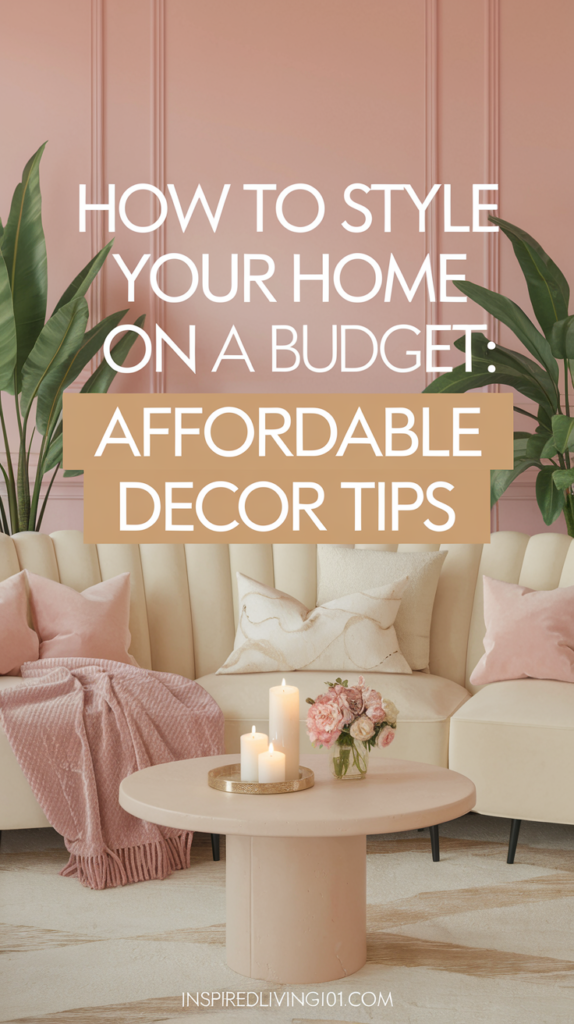
Did you know that 70% of homeowners spend under $500 annually on decor? If you’re part of that majority, this guide is for you. I’ve spent years transforming spaces without breaking the bank, and today I’m sharing proven strategies that work.
Decorating on a budget doesn’t mean sacrificing style. Through thrifting, DIY projects, and smart swaps, I’ve learned to create cozy, personalized spaces that feel far pricier than they are. This guide covers everything from spotting gold at thrift stores to upcycling old furniture into statement pieces—all while sticking to your budget.
Key Takeaways
- Thrifting saves money while finding unique budget home decor gems.
- DIY projects like painted furniture cut costs and add personal flair.
- Smart shopping strategies avoid the “decorating on a budget” trap of generic, store-bought items.
- Upcycling transforms overlooked objects into affordable home decorating treasures.
- Small changes like gallery walls or wall decals create big impacts without big budgets.
My Journey with Budget Home Decor
When I moved into my first apartment after college, I faced a tough reality: I wanted a stylish space but had little cash. Decorating on a budget wasn’t a choice—it was survival. This is how I turned necessity into a passion.
Why I Started Decorating on a Budget
Money was tight after student loans and part-time work. Thrift stores became my go-to. Early mistakes like buying cheap lamps that fell apart taught me quick lessons. I learned that “affordable” doesn’t mean “flimsy”—it means prioritizing quality and creativity over price tags.
How My Approach Has Evolved Over Time
My strategy shifted from scrambling for deals to planning. I started mixing DIY projects with curated thrift finds. Upcycling old furniture? It’s not just saving money—it’s storytelling. Now, I focus on timeless pieces that grow with my style.
What You’ll Learn from This Guide
- Smart shopping strategies for thrift stores and online marketplaces
- DIY hacks using items you already own
- How to avoid “cheap”-looking spaces while sticking to budget home decor principles
This guide isn’t just tips—it’s a mindset shift. You’ll discover that decorating on a budget means crafting a space that feels personal, not temporary. Let’s make every dollar (and every idea) count.
Setting Realistic Decorating Goals When Money Is Tight
Starting with a plan is key to affordable home decorating. Without clear goals, it’s easy to overspend on impulse buys or spread yourself too thin. I learned the hard way that small, intentional steps work better than trying to redo everything at once.
“A room isn’t finished until it tells your story,” says interior designer Emily Hart. This mindset helps focus on what truly matters.
Begin by auditing your space. Take photos of every room and list items you already own. Free apps like Canva or Pinterest let you create digital mood boards to visualize changes. This process shows what you can repurpose instead of buying new.
Next, prioritize spaces that have the most impact. The entryway or living area often make the biggest first impression. For low-cost home styling, start here before moving to less-trafficked rooms. Break goals into phases—maybe tackle one room per season.
- Set a per-room budget: Assign a dollar amount to each space and stick to it. Example: $50 for a dining room refresh.
- Separate needs from wants: A new rug for worn flooring is a need; decorative pillows can wait.
- Define your style: A cohesive vision prevents buying random items that don’t fit your aesthetic.
Patience is part of the process. Low-cost home styling thrives when changes are gradual. By focusing on what you can achieve now and planning future steps, you’ll avoid overwhelm and stay within your budget.
Thrift Store Treasure Hunting: The Ultimate Budget Decorator’s Secret
My best finds always came from midweek visits when new arrivals hit the shelves. One weekend, I stumbled upon a vintage oak dresser that became the centerpiece of my living room—proof that thrift stores hide gems waiting to be discovered.
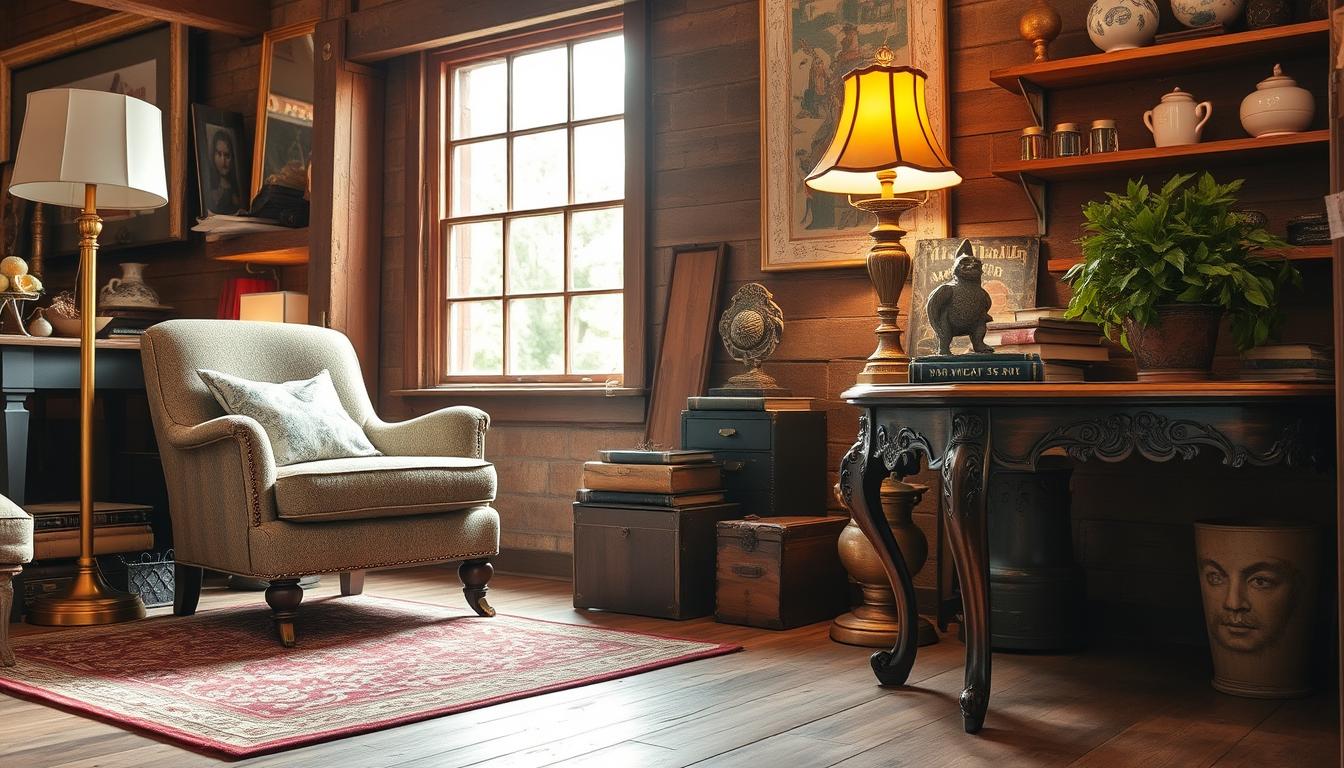
Best Days to Shop at Thrift Stores
Stores restock midweek, so visit Tuesdays or Wednesdays before crowds descend. Sales often drop on Fridays, but keep an eye out for weekend promotions. I’ve scored designer lamps and sturdy dining chairs on these days, perfect for a cheap home makeover without breaking the bank.
What Items Are Worth Buying Used
- Solid wood furniture (look for unchipped veneer)
- Picture frames and decorative vases
- Ceramic dishes in good condition
Avoid upholstered pieces with visible stains or electronics with frayed wires. Metal frames or glassware clean up easily and add instant style.
How to Spot Quality Pieces Among the Clutter
I check for brand names like Pottery Barn or Restoration Hardware on furniture. Dovetail joints on drawers mean sturdiness. Heft objects—the heavier, the better. A well-made side table from Goodwill once saved my dining room refresh.
Cleaning and Sanitizing Thrifted Items
Wood gets a vinegar polish. Textiles go through a hot wash with bleach. Spray metal surfaces with disinfectant and wipe. Sanitize ceramics in a dishwasher. A quick clean turns old pieces into fresh thrift store home finds highlights.
DIY Home Decor Projects Anyone Can Master
DIY home decor ideas are a game-changer for anyone looking to personalize their space without breaking the bank. Even with thrifted finds, creating your own pieces lets you match colors, styles, and themes perfectly. These projects require minimal tools and time, proving that budget home decor doesn’t mean sacrificing style. Here are three categories to start with:
https://www.youtube.com/watch?v=GK1VyI6EFdw
No-Sew Fabric Projects
Transform fabrics into functional decor with no stitching required:
- Envelope pillow covers: Wrap thrifted throw pillows with fabric using fusible tape. A $2 yard of material makes two throw pillows in 30 minutes.
- Fabric-wrapped boxes: Cover storage boxes with upholstery remnants. Secure edges with hot glue for under $5 in materials.
- Table runners: Use iron-on hem tape to finish fabric edges. Add a monogrammed letter with transfer paper for a custom look.
Simple Wood and Paint Transformations
Wood projects add instant warmth without carpentry skills:
- Picture frame refresh: Sand thrifted frames, paint them in bold colors, then add new glass. A $3 gallon of chalk paint transforms five small frames.
- Floating shelves: Cut untreated lumber to size, stain, and mount. Add brackets for under $20 total.
- Furniture facelift: Spray-paint an old dresser and swap handles. Total time: two hours, cost: under $15.
Wall Art You Can Make Tonight
Hang standout pieces without professional tools:
- Fabric collage frames: Layer wallpaper samples or scrap fabric in a shadowbox. No cutting required.
- Abstract art: Mix acrylic paints on canvas using sponges and palette knives. Even beginners can create gallery-worthy pieces in 30 minutes.
- Gallery walls: Use free printables from sites like Canva. Frame with thrifted mats for instant cohesion.
These projects cost less than $20 each and take under two hours. I’ve seen how mixing thrifted materials with simple techniques creates spaces that feel uniquely yours—without the high price tags.
The Art of Upcycling: Turning Trash into Stylish Treasures
Upcycling isn’t just a trend—it’s a game-changer for anyone chasing a cheap home makeover without sacrificing style. While basic DIY projects fix flaws, upcycling reimagines objects entirely. I’ve turned old ladders into floating shelves, painted mismatched suitcases into coffee tables, and even wired mason jars into chic pendant lights. These projects aren’t just cost-effective; they add personality to any space.
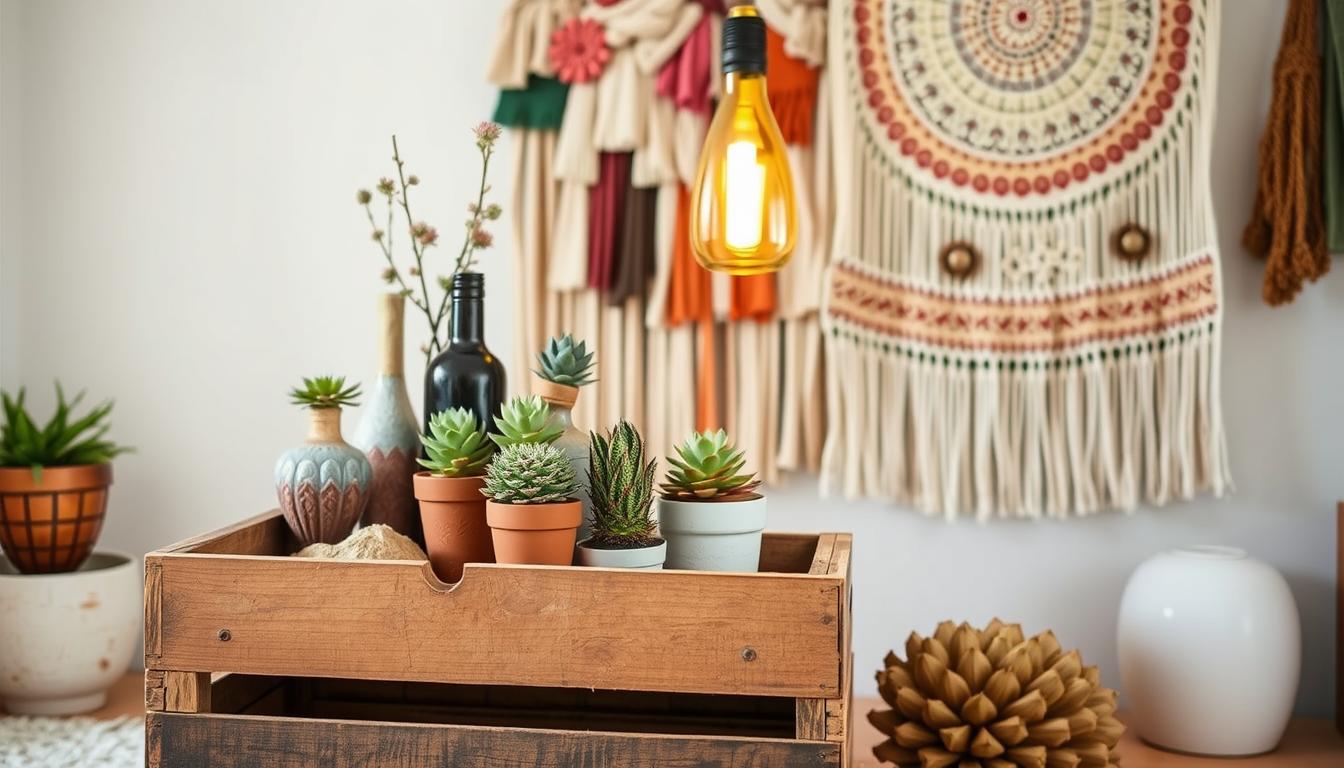
Start small. A cracked vase can become a terrarium base. Old shutters make perfect room dividers. My favorite source? Neighborhood curbside finds and Facebook Marketplace free sections. Thrift stores also hide gems—like a weathered trunk that becomes a stunning side table after a coat of chalk paint.
- Materials: Look for wood, metal, or glass items with potential
- Tools: Sandpaper, paint, glue, and creativity
- Time: Most projects take under two hours
“Upcycling isn’t about fixing—it’s about rebirth.”
Nature provides free materials too. Driftwood becomes wall art; pinecones painted gold add texture. The key? Ask yourself, “What could this become?” instead of “What’s wrong with this?” Every upcycled piece tells a story, making your space uniquely yours—all while saving money for a cheap home makeover. Sustainability meets style, one repurposed item at a time.
Budget-Friendly Wall Transformations Without Paint
Transforming walls doesn’t require a paintbrush. When I started exploring affordable home decorating, I found three game-changing solutions that add instant style without long-term commitments. Let’s dive into options that work for renters and homeowners alike.
Removable Wallpaper Options
Removable wallpaper is my top pick for bold statements. Brands like Tempaper and WallPops offer peel-and-stick options that mimic marble, botanicals, or abstract designs. I’ve used them on accent walls and even inside bookshelves—no damage, no regrets. Pro tip: Measure twice before applying to avoid bubbles!
Wall Decals and Stickers
Move beyond nursery themes with modern decals. Geometric vinyl patterns from Command or faux brick textures by Peel Smart add depth without permanence. Start small—a single large decal above a sofa can anchor a room. My favorite hack? Layer two coordinating designs for a custom look.
Gallery Walls Using What You Already Own
No need to buy art! I’ve built gallery walls with:
- Old travel postcards framed in uniform mats
- Small mirrors or picture frames flipped to show clean backs
- Stacked books arranged vertically in shadow boxes
- Printed quotes or vintage maps from thrift stores
Use washi tape to sketch layouts on the wall first—this ensures balance before drilling holes!
These tricks prove stylish budget-friendly decor doesn’t mean sacrificing style. Swap out elements seasonally to keep spaces fresh without spending more than $50.
Small Space Decorating: Making Limited Square Footage Feel Luxurious
When every inch counts, smart small space budget decor transforms tight quarters into cozy havens. I’ve learned that creativity, not cash, makes the difference. Here’s how to maximize without overspending.
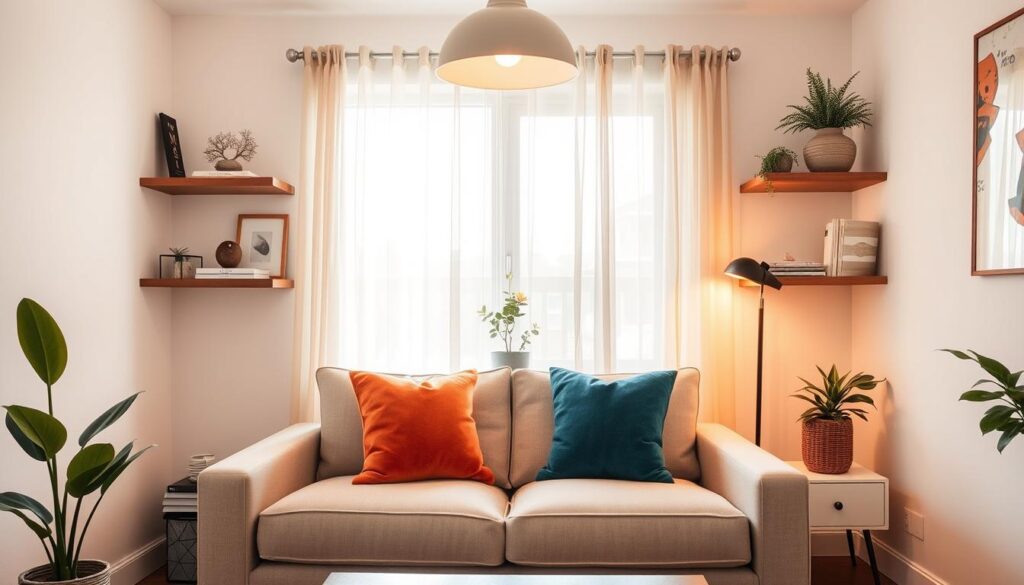
Multifunctional Furniture Ideas
- Storage ottomans for hidden blankets or games
- Drop-leaf tables that fold against walls
- Murphy beds to hide during the day
I converted an old ladder into a hanging plant rack—repurposing items adds charm on a dime.
Visual Tricks to Expand Your Space
- Position large mirrors opposite windows to double natural light.
- Use light-colored walls to reflect ambient light.
- Arrange furniture in a “conversational triangle” for open flow.
Storage Solutions That Double as Decor
| Item | Use | Benefit |
|---|---|---|
| Decorative baskets | Hold magazines/remote controls | Add texture without clutter |
| Floating shelves | Display plants and photos | Save floor space |
| Vintage suitcases | Bedside tables or decor stacks | Instant travel-themed storage |
My tiny apartment’s gallery wall uses thrifted frames in varying sizes. Grouping items close creates cohesion without low-cost home styling looking haphazard.
Seasonal Decor Swaps That Won’t Break the Bank
Seasonal changes don’t have to mean buying new decor. My affordable home decorating strategy revolves around a “capsule collection” of neutral basics paired with small, seasonal swaps. Think of it as styling your home like a wardrobe—core pieces stay, while accents rotate.
- Pillow covers in ivory, gray, or beige form the base.
- Vases, trays, and candles in neutral tones act as year-round staples.
- Reusable art frames that hold interchangeable prints.
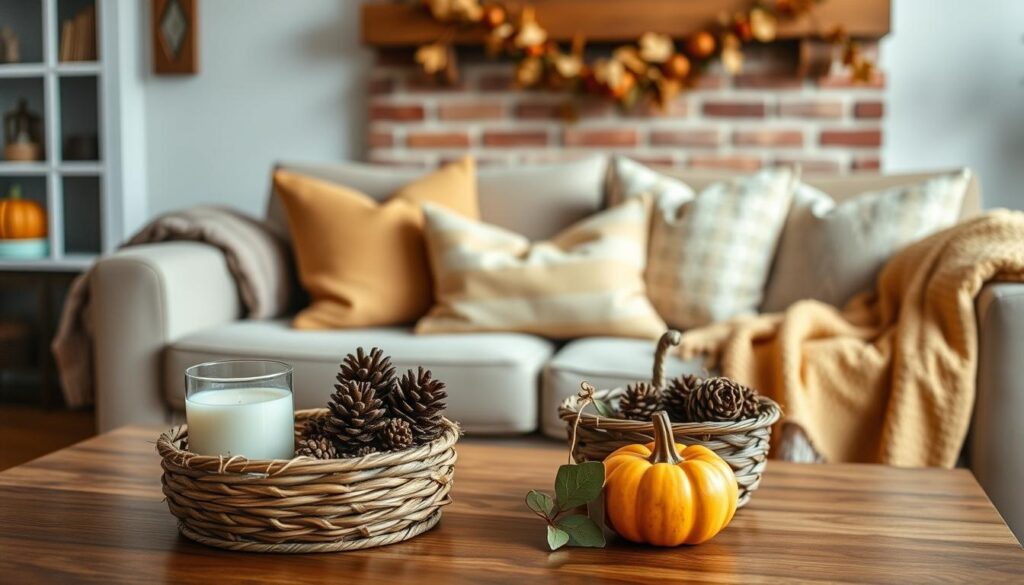
For each season, focus on one or two focal points. In fall, stack gourds from Walmart in a neutral bowl. Winter calls for pinecones gathered outdoors paired with LED string lights. Spring blooms? Swap in faux flowers from Michaels. Summer? Add woven baskets filled with seashells.
“Rotate, don’t hoard—your storage space and wallet will thank you.”
I store seasonal items in labeled bins by season. A clear bin with “Fall 2024” tags keeps track of what I own. This budget home decor system cuts waste and avoids impulse buys. For holidays, repurpose everyday items: turn mason jars into lanterns with tissue paper or glue buttons to plain frames for instant ornaments.
My rule? Stick to three seasonal decor pieces per room. This keeps your space fresh without overwhelming your budget or storage.
Shopping Strategies: When to Splurge vs. When to Save
Decorating on a budget doesn’t mean sacrificing quality forever. Knowing when to spend smartly and when to save can make your space look polished without overspending. Here’s how to balance your budget without breaking your style.
Invest in What Lasts
- Quality sofas—prioritize durability over trends. A sturdy frame lasts years, saving money long-term.
- Area rugs anchor rooms. A well-made rug adds warmth and style for decades.
- Mattresses are non-negotiable. Sleep is worth investing in comfort.
Save on the Rest
Swap out these often for fresh looks without big costs:
- Throw pillows
- Picture frames
- Seasonal decor
- Accent chairs
“I waited six months for a leather sofa sale. Now it’s the centerpiece of my living room.”
Timing Matters
| Category | Best Time to Buy |
|---|---|
| Outdoor furniture | End of summer (post-memorial day sales) |
| Holiday decor | Right after holidays (Black Friday, post-Christmas) |
| Lighting fixtures | January white sales |
Look for open-box items at big-box stores and check clearance sections weekly. Patience pays—waiting for sales often means better decorating on a budget results.
Creating a Cohesive Look With Mismatched Budget Finds
Decorating with thrift store home finds doesn’t mean your space has to look haphazard. Over years of experimenting, I’ve learned to turn diverse pieces into a unified style. Here’s how:
- Paint it uniform: Restyle mismatched furniture with the same color. A white console, a painted dresser, and a thrifted bookshelf in ivory create instant cohesion.
- Repeat shapes: Use geometric lamps, round mirrors, or square frames to tie rooms together visually.
- Edit color palettes: Stick to 3-4 colors across all textiles and accessories. Navy, cream, and mustard work magic in my living room.
“A curated collection tells a story. Chaos is just bad editing,” says interior designer Clara Nguyen. Her advice: edit ruthlessly.
Balance is key. Place a tall plant next to a low stack of books to create asymmetrical harmony. Ask yourself: does this new find echo a shape, color, or material I already own? If not, pass. The “power of three” helps too—group items in odd numbers (three throw pillows, three framed photos) to avoid clutter.
My process? Before buying, I visualize the piece in my space. Does it fit my color rules? Will it complement existing textures? Every stylish budget-friendly decor space starts with these choices. Embrace the “collected over time” vibe—it’s what makes your home unique.
The Psychology of Color: Free Ways to Transform Your Space
Color choices can completely change how a room feels—all without spending a dime. By rearranging existing items and using light, you can create a fresh look that feels like a cheap home makeover. Understanding basic color psychology lets you turn your space into a mood-lifted zone through smart organization and free or low-cost adjustments. Here’s how to make it work for you:
Start with mood-boosting combos. For energy, pair sunny yellows with crisp whites. Calm spaces thrive with blues and greens. To focus better, try warm neutrals like beige or taupe. These palettes cost nothing to apply—just move items like throw pillows or blankets to shift vibes.
Working with fixed colors like dark floors? Add complementary accents. A red rug under a neutral couch creates contrast without replacing furniture. Use whites or grays to low-cost home styling by balancing bold elements. Layering textiles in similar tones softens harsh tones like bright yellow walls.
Avoid common pitfalls. Jarring contrasts (like red walls with green chairs) feel chaotic. Overloading small rooms with clashing hues makes them feel cramped. Test changes first: drape a blue throw over a sofa before painting. Mistakes like mismatched scale (tiny red pillows on a large beige couch) dilute impact. Always use one dominant color and secondary accents.
Color is free real estate. Rearrange what you own, then test lighting—warm bulbs for cozy vibes, cool tones for bright spaces. A thoughtfully placed throw or vase can transform a room’s energy instantly.
Digital Resources for Budget Home Decor Inspiration
Online communities and tools are goldmines for DIY home decor ideas and upcycled home decor projects. Let me share my top picks to simplify your search:
- Pinterest: Follow boards like “Thrifty Home Makeovers” or “Upcycled Furniture Hacks” for instant project ideas.
- Instagram: Accounts like @BudgetDecorBlogger and @UrbanJunkRehab show real people transforming secondhand finds. No fancy studios—just honest tips.
- YouTube: Channels like DIYDecorChannel focus on zero-budget projects. Their “Garage Sale Glam” series turned my old bookshelf into a focal point.
- Podcasts: The “Thrifty Interior Design” podcast interviews crafters who use $50 or less per room. Episodes on repurposing curtains as headboards changed my mindset.
- Apps: RoomSketcher lets me test layouts virtually. The free version helped me rearrange my living room without buying a thing.
“Sharing mistakes online helped me avoid buying $200 lamps I didn’t need.”
I organize saves into digital folders by room and project type. Apps like Pocket keep tutorials handy when I’m offline. And never overlook Facebook groups like “DIY Decor Swap” where members share free materials. Staying focused on authentic, low-cost content means avoiding sponsored posts that push expensive products. These tools made my journey easier—and they can do the same for you.
My Biggest Budget Decorating Mistakes (So You Don’t Repeat Them)
Decorating on a budget taught me hard lessons the fun way. Here’s what I learned the hard way—and how you can skip the stress:
Impulse Purchases I Regret
Buying that “steal” accent chair online? It arrived twice my living room’s size. Now I always measure spaces first. Trendy decor? A faux plants collection looked dated in months. Rule: Wait 48 hours before buying anything non-essential.
False Economies That Cost More
- Buying three $10 lamps from Target instead of one $30 IKEA piece? All broke within a year. Quality counts.
- Skip “disposable” decor. Cheap throw pillows stain easily, and acrylic art cracks. Invest in one sturdy piece over many flimsy ones.
Avoiding the “Cheap Look”
Mass-produced items scream budget. Fix it with:
- Mix textures: Combine smooth, rough, and metallic surfaces.
- Embrace mismatched patterns: A checked tablecloth with polka-dot curtains feels intentional.
- Edit ruthlessly: Less clutter = more sophistication.
“A room’s soul isn’t in its price tag, but in its harmony.” – Emily Henderson
Remember: affordable home decorating isn’t about cutting corners. It’s about smart choices. Learn from my mistakes to create spaces that feel curated, not rushed.
Conclusion: Creating a Home You Love Shouldn’t Empty Your Wallet
Stylish budget-friendly decor isn’t about buying less—it’s about seeing potential in every corner. My own journey from a drab, store-bought living room to a space layered with flea-market finds and DIY accents proved that patience and creativity matter more than price tags. The key is choosing focal points like a repurposed coffee table or a gallery wall that tell your story without costing a fortune.
Budget home decor thrives on intentionality. Start small: Swap a thrifted rug to warm up a room, or paint a flea-market shelf in bold color. Every smart swap builds toward a space that’s uniquely yours. Avoid the trap of “quick fixes”—invest in one standout piece instead of many mediocre ones. Remember, the satisfaction comes from transforming objects and spaces through your own hands and vision.
Share your wins—like that first successful upcycle—with communities like Apartment Therapy’s forums or Pinterest groups. Decorating on a budget is a mindset, not a limitation. Your home can feel like a magazine spread without ever emptying your savings. Begin today with one idea from this guide. Your stylish, wallet-friendly transformation starts now.




